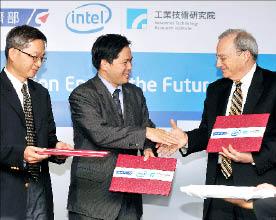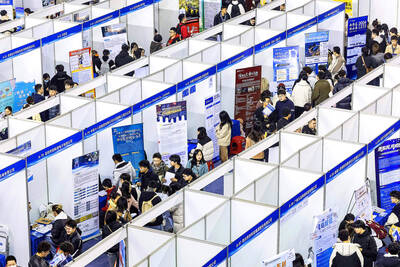Intel Corp yesterday unveiled its latest partnership with Taiwanese research powerhouse Industrial Technology Research Institute (ITRI, 工研院), a US$15-million research program that would run over the next five years to develop new-generation memory technologies for smaller and “greener” chips for mobile devices and cloud-technology-based data centers.
Intel would inject US$5 million in funding and resources, while ITRI and the Ministry of Economic Affairs would channel US$10 million into the research project.
Instead of developing process technologies for chip manufacturing, the collaboration aimed at finding the optimized structure of memory chips that could provide better performance with lower power consumption, vice president and chief technology officer of Intel Justin Rattner told a media briefing in Taipei.

Photo: CNA
“The partnership’s initial project will focus on super-fast, but extremely energy-efficient memory technologies for future ultra-mobile devices, such as Ultrabooks, tablets and smartphones, as well as tomorrow’s exascale and cloud mega-data centers,” Rattner said.
The general director of ITRI’s Information and Communications Research Laboratories, Wu Cheng-wen (吳誠文), said ITRI would focus on developing 3D IC technology to make memory chips work better with microprocessors, or to integrate memory chips with microprocessors.
“With the many patented technologies from Intel and ITRI’s solid 3D IC research and development capabilities, this collaboration will enable the development of future memory technologies,” Wu said.
“This project will also create a new field for local memory chip makers to produce chips [with more value] using their existing technologies, rather than scramble to invest massively on upgrading processing technologies,” he added.
The 3D IC technology for memory chips could effectively reduce the space required by hardware, enable faster data transmission and expand capacity to cope with the uptake of sleek consumer electronic devices, ITRI said.
Wu expects ITRI’s collaboration with Intel to bear fruit within three years, at the earliest. The research house would then transfer the memory technologies and patents to local companies interested in manufacturing new-generation memory chips.
The government-backed ITRI has long been playing a key role in developing cutting-edge technologies to support the development of Taiwan’s industries, particularly the semiconductor industry.
ITRI is in talks with Taiwanese semiconductor companies and mostly memory-chip companies to join this project, Wu said, adding that chip designers, chip packagers and contract chip makers have also expressed interest in participating in this program. He declined to reveal the names of the companies ITRI had approached.
Wu expects local companies to participate in the ITRI-Intel program for one year after the launch.

Stephen Garrett, a 27-year-old graduate student, always thought he would study in China, but first the country’s restrictive COVID-19 policies made it nearly impossible and now he has other concerns. The cost is one deterrent, but Garrett is more worried about restrictions on academic freedom and the personal risk of being stranded in China. He is not alone. Only about 700 American students are studying at Chinese universities, down from a peak of nearly 25,000 a decade ago, while there are nearly 300,000 Chinese students at US schools. Some young Americans are discouraged from investing their time in China by what they see

MAJOR DROP: CEO Tim Cook, who is visiting Hanoi, pledged the firm was committed to Vietnam after its smartphone shipments declined 9.6% annually in the first quarter Apple Inc yesterday said it would increase spending on suppliers in Vietnam, a key production hub, as CEO Tim Cook arrived in the country for a two-day visit. The iPhone maker announced the news in a statement on its Web site, but gave no details of how much it would spend or where the money would go. Cook is expected to meet programmers, content creators and students during his visit, online newspaper VnExpress reported. The visit comes as US President Joe Biden’s administration seeks to ramp up Vietnam’s role in the global tech supply chain to reduce the US’ dependence on China. Images on

Taiwan Transport and Storage Corp (TTS, 台灣通運倉儲) yesterday unveiled its first electric tractor unit — manufactured by Volvo Trucks — in a ceremony in Taipei, and said the unit would soon be used to transport cement produced by Taiwan Cement Corp (TCC, 台灣水泥). Both TTS and TCC belong to TCC International Holdings Ltd (台泥國際集團). With the electric tractor unit, the Taipei-based cement firm would become the first in Taiwan to use electric vehicles to transport construction materials. TTS chairman Koo Kung-yi (辜公怡), Volvo Trucks vice president of sales and marketing Johan Selven, TCC president Roman Cheng (程耀輝) and Taikoo Motors Group

New apartments in Taiwan’s major cities are getting smaller, while old apartments are increasingly occupied by older people, many of whom live alone, government data showed. The phenomenon has to do with sharpening unaffordable property prices and an aging population, property brokers said. Apartments with one bedroom that are two years old or older have gained a noticeable presence in the nation’s six special municipalities as well as Hsinchu county and city in the past five years, Evertrust Rehouse Co (永慶房產集團) found, citing data from the government’s real-price transaction platform. In Taipei, apartments with one bedroom accounted for 19 percent of deals last